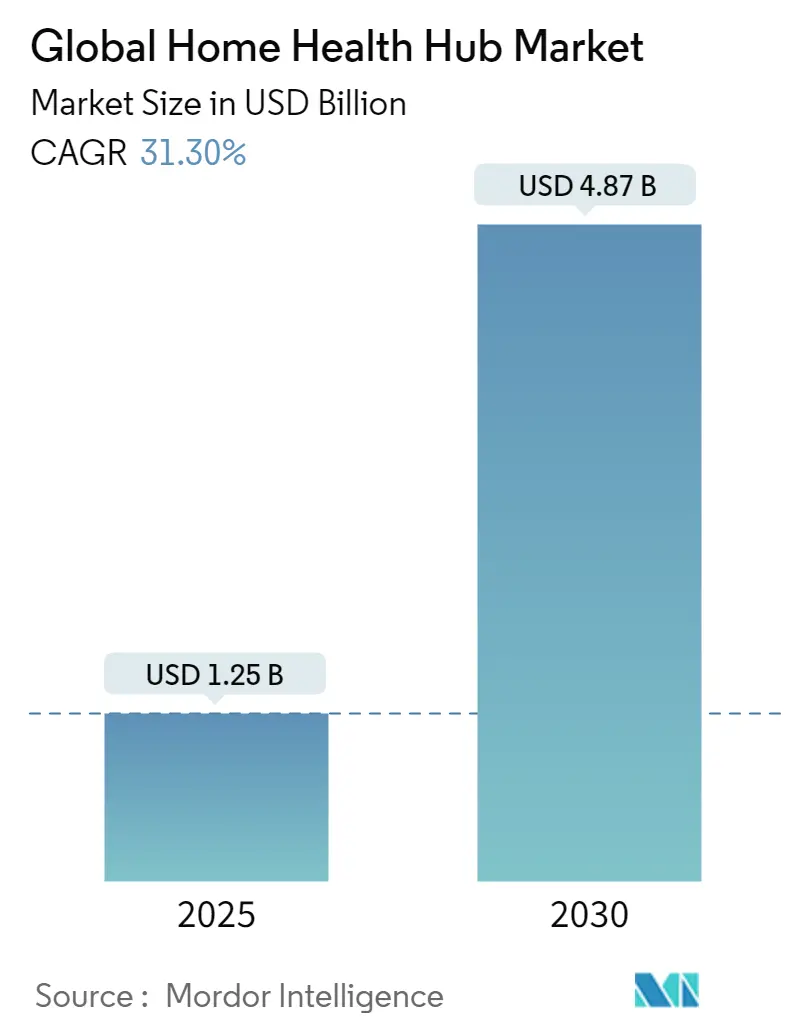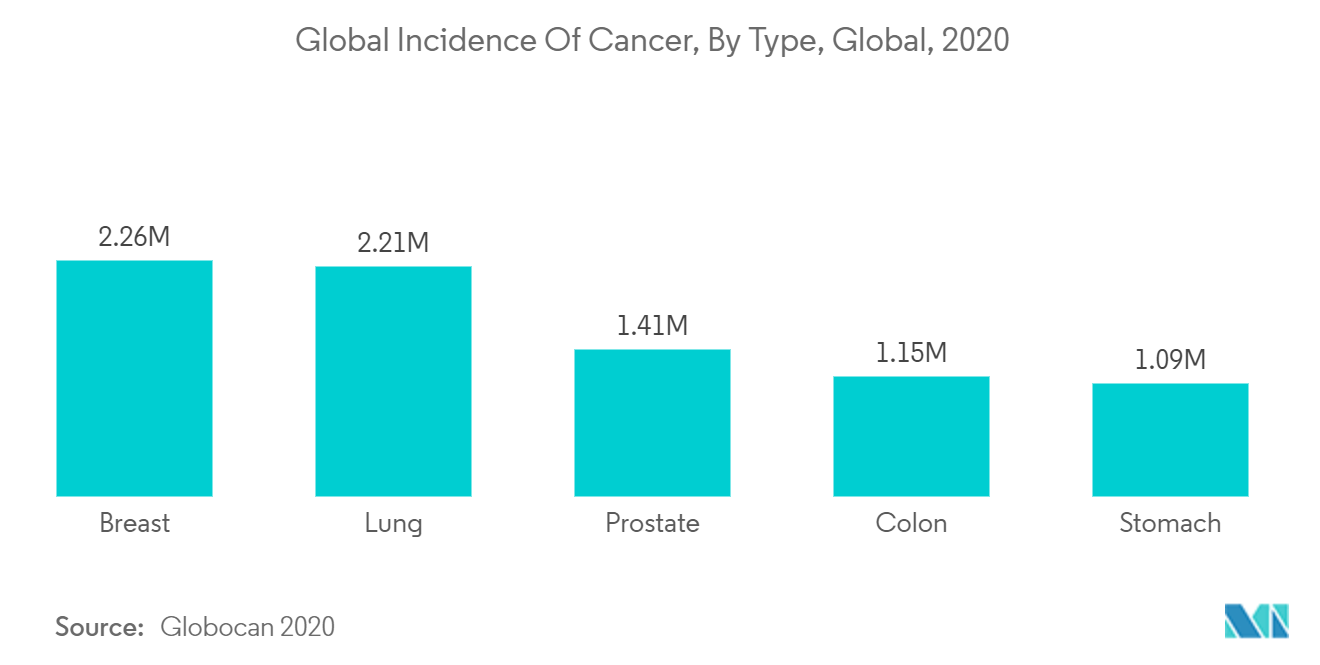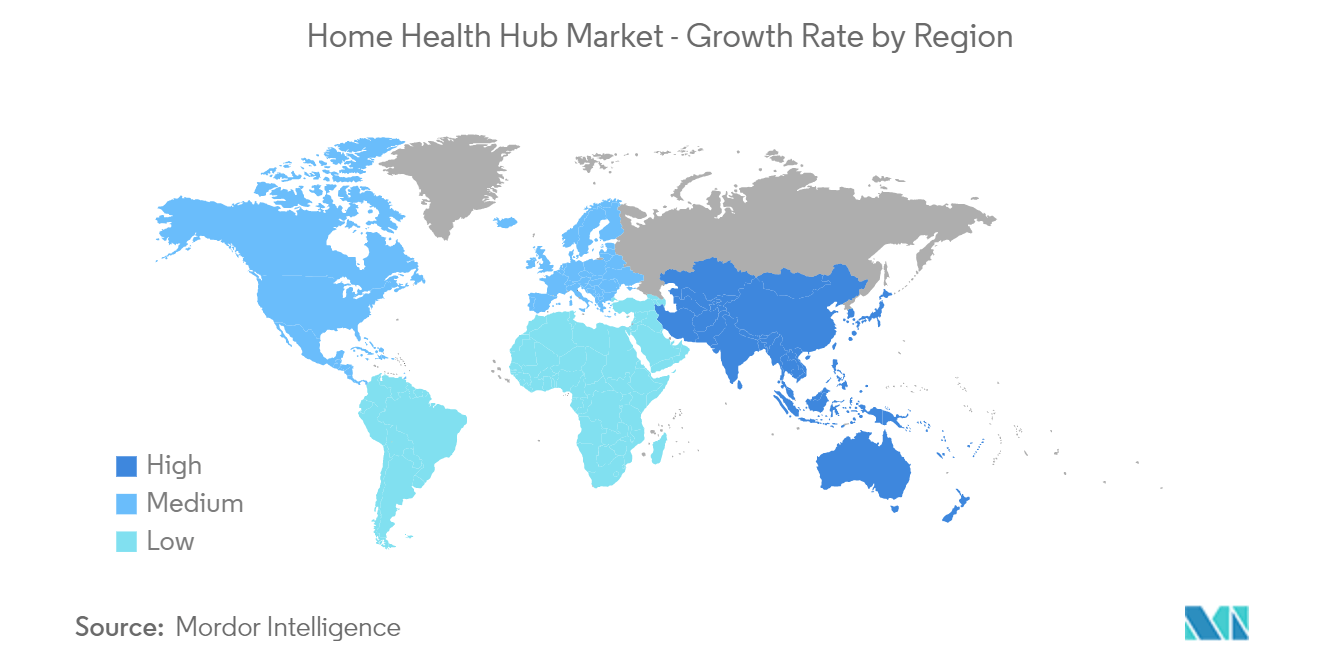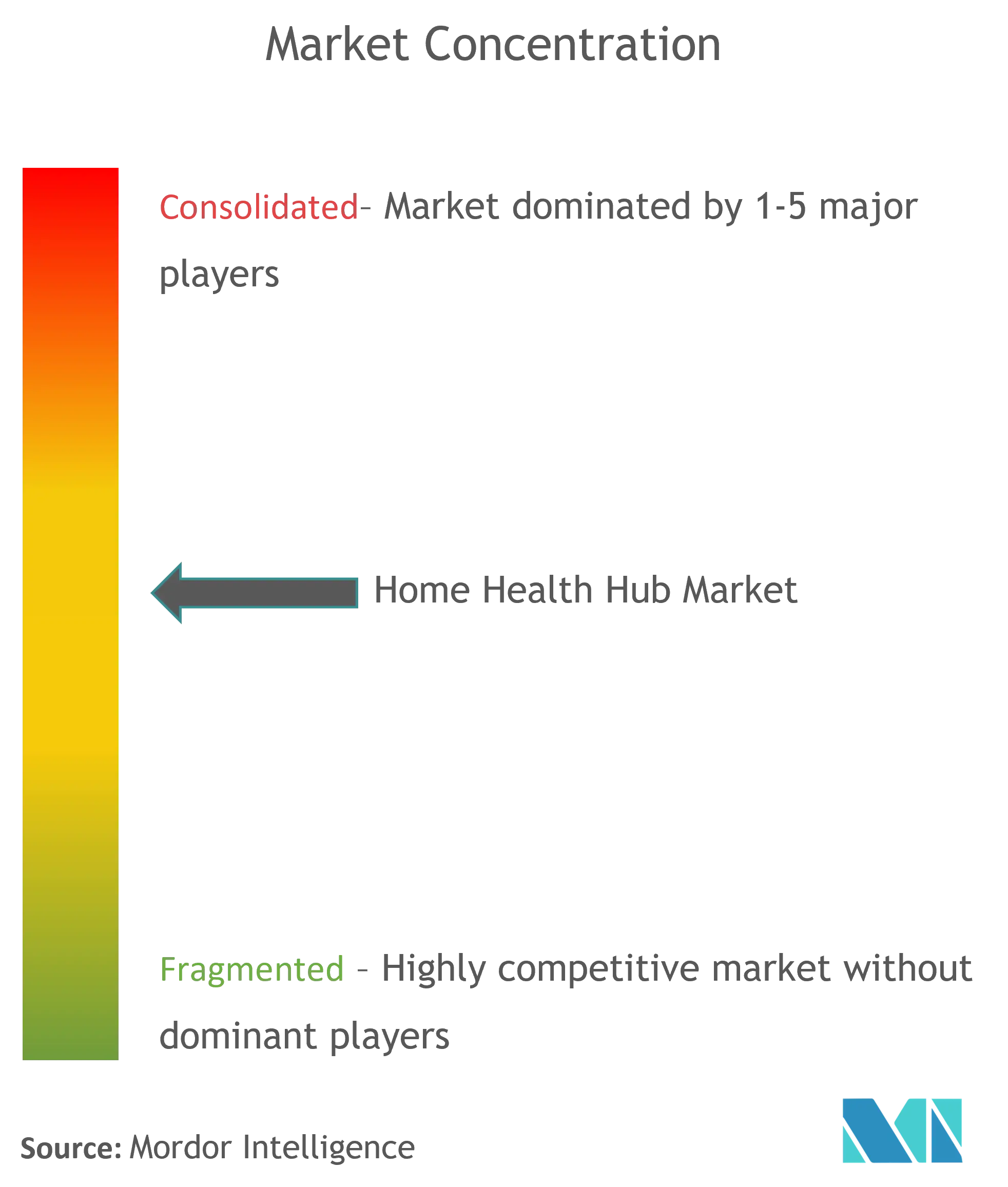Global Home Health Hub Market Size and Share

Global Home Health Hub Market Analysis by Mordor Intelligence
The Global Home Health Hub Market size is estimated at USD 1.25 billion in 2025, and is expected to reach USD 4.87 billion by 2030, at a CAGR of 31.3% during the forecast period (2025-2030).
Globally, the COVID-19 pandemic put enormous pressure on hospitals and healthcare systems that were understaffed and overworked. Home health hub technology helped patients to remain safe within their homes while reducing stress on hospitals, emergency rooms, and front-line healthcare workers during the pandemic, which shows a positive impact on the market. According to the study titled "COVID-19's impact on home health services, caregivers and patients: lessons from the French experience," published in the Lancet Regional Health in August 2021, Since the start of the Covid-19 pandemic, home-based care has been in high demand to relieve hospital overcrowding and allow patients with chronic diseases or non-severe Covid-19 to be cared for and monitored at home. Thus, the home health hub market was positively impacted by COVID-19.
The Home Health Hub Market is predicted to develop as the number of chronic diseases rises, and the geriatric population grows. Additionally, the expanding use of smartphones, as well as the growing desire to cut healthcare costs, are both driving the market forward. According to the July 2021 update by the World Health Organization, cardiovascular diseases are the leading cause of death around the world, including diseases like coronary heart disease, cerebrovascular disease, rheumatic heart disease, congenital heart disease, and others. As per the same source, in 2019, 17.9 million people around the world died from cardiovascular diseases, which amounted to about 32% of all global deaths. Additionally, The Globocan 2020 report published by Global Cancer Observatory estimated the incidence and mortality of 36 cancer in 185 countries. Globally, there were an estimated 19,292,789 new cases of cancer diagnosed in 2020, and about 9,958,133 people died due to cancer all over the world. Further, as per the same source, the number of new cancer cases is expected to reach 24,044,406 by 2030, which shows an increasing prevalence of cancer around the globe.
The geriatric population is expected to have a significant impact on the market studied as people aged above 65 are more prone to chronic diseases. According to the World Health Organization Facts of 2021, the proportion of the global population aged 60 and up will nearly double from 12% to 22% between 2015 and 2050. By 2050, 80% of the world's elderly will live in low- and middle-income countries. The population is aging at a much faster rate than in the past. Every country faces significant challenges in ensuring that its health and social systems are prepared to take advantage of this demographic shift.
However, various key strategic activities by the market players are anticipated to boost the market over the forecast period. For instance, in March 2022, VEON Ltd., a global provider of connectivity and internet services, announced that it is Banglalink mobile operator in Bangladesh had launched Health Hub, the country's first integrated digital health platform.
Thus, all aforementioned factors are expected to drive the market over the forecast period. However, security and privacy concerns and reimbursement issues are the factors that might restrict the growth of the market.
Global Home Health Hub Market Trends and Insights
Smartphone-based Segment is Expected to Dominate the Market Over the Forecast Period
The growing popularity of digital platform smartphones has fueled the growth of the Smartphone-Based Hubs sector, which now has the largest market share. Mobile programs (Android, iOS, Linux, and Windows) that can be downloaded to dedicated smartphones and tablets are required for smartphone-based hubs. Smartphones and tablets are becoming the primary means of internet connectivity in developed nations, and their use is increasing in developing countries.
Increased use of mobile platforms to improve patient information accessibility is being driven by increased smartphone usage and the continuous growth of high-speed mobile networks. Smartphone-enabled home health hubs are expected to rise in popularity as awareness and accessibility grow. A growing preference for smartphone technology and the internet and mounting demand for smartphone-based health hub is expected to boost the market growth. As per Eurostat data, by updates from December 2022, by 2021, the share of EU households with internet access had risen to 92%, some 20 percentage points higher than in 2011 (72%). Moreover, broadband internet access was used by 90% of the households in the EU in 2021, 25 percentage points higher than in 2011 (65%).
Furthermore, product launches by the key market players are anticipated to boost the market over the forecast period. For instance, in March 2022, the GRS India startup launched a new smartphone-based portable oxygen kit that can provide consistent oxygen supply during disasters and medical emergencies.
Thus, all aforementioned factors are expected to boost the market over the forecast period.

North America Dominates the Market and Expected to do Same in the Forecast Period.
Factors such as the high adoption of sophisticated technology, the prevalence of chronic and lifestyle diseases, rising healthcare spending, physician shortages, and increasing demand for better healthcare services are all contributing to North America's big share of the worldwide market. According to the Globocan 2020 report, an estimated 2,281,658 new cancer cases were diagnosed in the United States in 2020, with nearly 612,390 deaths. In 2020, The most common cancers were breast (253,465), lung (227,875), prostate (209,512), and colon (101,809) in the United States.
Additionally, the rise in healthcare expenditure and growth in disposable income also drive the market for home health hubs across the globe. According to the PETERSON-KFF Health System Tracker data published in February 2022, the United States health care spending increased 9.7% to reach USD 4.1 trillion in 2020, a much faster rate than the 4.3% increase seen in 2019. The acceleration in 2020 was due to a 36.0% increase in federal expenditures for health care that occurred largely in response to the COVID-19 pandemic. The average annual growth in health spending from 2010-2019 was 4.2%. The largest shares of total health spending were sponsored by the federal government (36.3%) and the households (26.1%). The private business share of health spending accounted for 16.7% of total health care spending, state and local governments accounted for 14.3%, and other private revenues accounted for 6.5%.
Furthermore, according to the study titled "Ensuring Quality Cancer Care through the Oncology Workforce: Sustaining Care in the 21st Century: Workshop Summary," published in the National Library of Medicine in October 2020, the United States faces a potential shortage of more than 1 million nurses by 2020. Thus increasing shortage of healthcare workforce in the country increases the adoption of home health hubs. Thus, all aforementioned factors are anticipated to boost the segment growth over the forecast period.

Competitive Landscape
The competitive character is influenced by technical breakthroughs and the quick adoption of new devices for better treatment. Furthermore, as important competitors focus more on global development, strategic collaborations, partnerships, and product releases in the future years, competition amongst them will heat up. Major players include OnKöl, INSUNG INFORMATION CO, LTD., IDEAL LIFE INC., iHealth Labs Inc., Honeywell International Inc., Vivify Health, Inc.
Global Home Health Hub Industry Leaders
Lamprey Networks,
iHealth Lab
Koninklijke Philips N.V.,
Inhealthcare,
Capsule Technologies Inc.,
- *Disclaimer: Major Players sorted in no particular order

Recent Industry Developments
- In March 2022, VEON Ltd. a global provider of connectivity and internet services reported that it's Banglalink mobile operator in Bangladesh has launched Health Hub, the country's first integrated digital health platform.
- In January 2021, Philips expanded its leadership in inpatient care management solutions for the hospital with the acquisition of Capsule Technologies, Inc.
Global Home Health Hub Market Report Scope
As per the scope of the report, a home health hub is a software platform that proactively organizes, cares for, and manages chronic diseases for improved results by connecting the health caregiver and the patient through the patient's electronic devices. Significant advancements in connected home and mobile technology are improving the efficiency and automation of data collecting from patients. This improves hospital and patient connectivity, resulting in better healthcare delivery and care quality. The Home Health Hub Market is Segmented by Product and Services (Smartphone-Based, Standalone, Services), Type of Patient Monitoring (High-Acuity Patient Monitoring, Moderate-Acuity Patient Monitoring, Low-Acuity Patient Monitoring), End User (Hospitals, Healthcare Payers, Home Care Agencies), and Geography (North America, Europe, Asia-Pacific, Middle-East and Africa, and South America). The report offers the value (in USD million) for the above segments.
| Smartphone-Based Hubs |
| Standalone Hubs |
| Services |
| High-Acuity Patient Monitoring |
| Moderate-Acuity Patient Monitoring |
| Low-Acuity Patient Monitoring |
| Hospitals |
| Home Care Agencies |
| Healthcare Payers |
| North America | United States |
| Canada | |
| Mexico | |
| Europe | Germany |
| United Kingdom | |
| France | |
| Italy | |
| Spain | |
| Rest of Europe | |
| Asia-Pacific | China |
| Japan | |
| India | |
| Australia | |
| South Korea | |
| Rest of Asia-Pacific | |
| Middle East and Africa | GCC |
| South Africa | |
| Rest of Middle East and Africa | |
| South America | Brazil |
| Argentina | |
| Rest of South America |
| By Product and Services | Smartphone-Based Hubs | |
| Standalone Hubs | ||
| Services | ||
| By Type of Patients Monitoring | High-Acuity Patient Monitoring | |
| Moderate-Acuity Patient Monitoring | ||
| Low-Acuity Patient Monitoring | ||
| By End User | Hospitals | |
| Home Care Agencies | ||
| Healthcare Payers | ||
| Geography | North America | United States |
| Canada | ||
| Mexico | ||
| Europe | Germany | |
| United Kingdom | ||
| France | ||
| Italy | ||
| Spain | ||
| Rest of Europe | ||
| Asia-Pacific | China | |
| Japan | ||
| India | ||
| Australia | ||
| South Korea | ||
| Rest of Asia-Pacific | ||
| Middle East and Africa | GCC | |
| South Africa | ||
| Rest of Middle East and Africa | ||
| South America | Brazil | |
| Argentina | ||
| Rest of South America | ||
Key Questions Answered in the Report
How big is the Global Home Health Hub Market?
The Global Home Health Hub Market size is expected to reach USD 1.25 billion in 2025 and grow at a CAGR of 31.30% to reach USD 4.87 billion by 2030.
What is the current Global Home Health Hub Market size?
In 2025, the Global Home Health Hub Market size is expected to reach USD 1.25 billion.
Who are the key players in Global Home Health Hub Market?
Lamprey Networks,, iHealth Lab, Koninklijke Philips N.V.,, Inhealthcare, and Capsule Technologies Inc., are the major companies operating in the Global Home Health Hub Market.
Which is the fastest growing region in Global Home Health Hub Market?
North America is estimated to grow at the highest CAGR over the forecast period (2025-2030).
Which region has the biggest share in Global Home Health Hub Market?
In 2025, the Asia-Pacific accounts for the largest market share in Global Home Health Hub Market.
What years does this Global Home Health Hub Market cover, and what was the market size in 2024?
In 2024, the Global Home Health Hub Market size was estimated at USD 0.86 billion. The report covers the Global Home Health Hub Market historical market size for years: 2019, 2020, 2021, 2022, 2023 and 2024. The report also forecasts the Global Home Health Hub Market size for years: 2025, 2026, 2027, 2028, 2029 and 2030.
Page last updated on:
Global Home Health Hub Market Report
Statistics for the 2025 Global Home Health Hub market share, size and revenue growth rate, created by Mordor Intelligence™ Industry Reports. Global Home Health Hub analysis includes a market forecast outlook for 2025 to 2030 and historical overview. Get a sample of this industry analysis as a free report PDF download.



